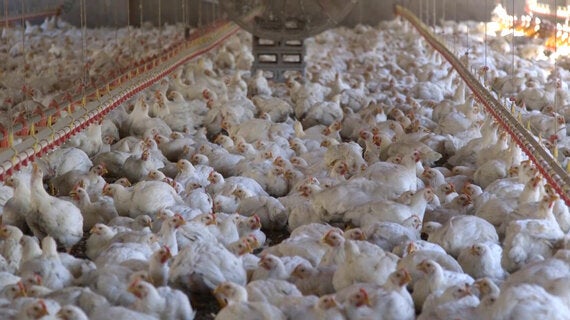We've been fighting the use of cages for animal products for decades. From fur farming to bear-bile extraction to egg production, these cages are generally designed to do one thing - make the most products as quickly and cheaply as possible.
But behind the stainless steel mesh, the true cost is clear - confined animals living in bleak, often over-crowded conditions with no way of behaving naturally. And now, another worrying trend is looming - the use of cages to grow chickens for meat.

© World Animal Protection
Over 60 billion chickens are farmed annually for meat consumption with 40 billion of them reared in factory farms. Most of these intelligent animals spend their short, sorry lives in large, windowless warehouses filled with tens of thousands of other chickens. Conditions in these farms are bad enough but the use of cages to grow chickens takes the suffering to another level.
A typical caged-chicken warehouse features row upon row of stacked cages. This looks like a fully-stocked, windowless supermarket where every product on the shelves is a living, breathing animal. Many tens of chickens will live in the same cage, which, at their most crowded, provide two chickens with a space roughly equivalent in size to an A4 sheet of paper.
The chickens' waste is meant to fall through grids before being transported away by conveyor belts underneath, but this doesn't always happen. The same belts are used to remove the chickens for slaughter after just six weeks or so, when they are still babies.
This short life span has been made possible through extreme genetic selection, forcing the chickens to endure rapid weight gain. In this sense, the chickens themselves are born to suffer, as this weight gain often leads to a host of painful physiological problems - this is not a life worth living.
Chicken cages are growing in popularity and it's now becoming a global problem - a quick internet search produces glossy pictures of sparkling cages, often without any chickens in them, alongside bold claims that this is the future of chicken farming. But is this really food production fit for the 21st century?
The use of cages to farm animals is a deeply flawed, unsavoury notion that shocks everyone I talk to about this issue. And don't just take my word for it - over the last few years, some of the world's largest food companies, including McDonald's, Starbucks and Nestlé, have committed to move away from the use of cages for egg-laying hens. These forward-thinking companies understand that their customers are looking for food options from kinder farming systems.
We at World Animal Protection want to see the world's leading fast-food retailers take a leadership stance and pledge to keep caged-chicken meat off their menus. We've already made progress; in recent discussions with McDonald's just last week, the company confirmed that they do not accept the use of cages to grow chickens. We're thrilled to see a global fast-food retailer taking a positive first step on chicken welfare, and hope this example will encourage other fast-food brands to do the same.
We're now calling on KFC, Nando's, Starbucks, Burger King, Pizza Hut, Domino's and Subway to make the same commitment. Read more about our campaign to find out how you can help us improve the lives of millions of animals, just as we've done for egg-laying hens.

© World Animal Protection